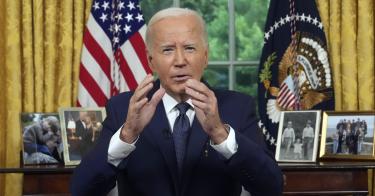At a central bankers’ conference in Portugal last week, Federal Reserve Chairman Jerome Powell congratulated himself on his fight against inflation, leading markets to rally back home. But it must have been impossible for him to have missed that his European hosts were able to boast of much better success.
This is bad news for President Joe Biden, who continues to insist that his deficit spending had nothing to do with price rises. Inflation, Biden and his defenders contend, has been a global phenomenon.
Biden also lies that his predecessor, former President Donald Trump, left him a 9% inflation rate in January 2021.
Since taming inflation will be one of the top jobs of whoever wins the White House in November, it is wise to consider what else can be done beyond the obvious—stop spending taxpayer money like drunken sailors!
In the Heritage Foundation’s “Mandate for Leadership,” economist Paul Winfree recommends structural changes.
>>> Feeling the Financial Pinch? Here’s Why
One recommendation is for the Fed to eliminate its “dual mandate” of keeping prices low and maintaining full employment. Focus on the former only, Winfree says. Another is to limit the Fed’s function as a “lender of last resort” for banks that overlend during periods of low interest rates, which rewards “reckless lending.”
Importantly, Winfree also recommends winding down the Fed’s balance sheet, which has exploded in size and encourages federal deficits, including trillions in federal debt. And to eliminate picking winners and losers, the Fed should stop purchases of corporate and municipal debt and limit its balance sheet holdings to U.S. Treasurys.
It’s unlikely that Biden will follow any of this advice. He repeated the canard about the inflation rate that Trump left him as recently as last month, when he told Yahoo News, “It was at 9% when I came in, and it’s now down around 3%,” prompting a rebuke even from CNN.
“Biden’s claim that the inflation rate was 9% when he became president is not close to true. The year-over-year inflation rate in January 2021, the month of his inauguration, was about 1.4%,” CNN said.
Inflation did reach 9%, but it was in June 2022, a year and a half after Biden had been in office, and 13 months after passage of the $1.9 trillion American Rescue Plan, a gargantuan stimulus bill signed just as the nation was opening up after COVID-19. The stimulus payments encouraged people to stay home just as the economy was taking off, forcing employers to raise wages to attract workers and driving up inflation.
As David Winston wrote for Roll Call, “Prior to the passage of the American Rescue Plan (including the month it was signed into law), inflation had been under 3% for 111 straight months. In the 35 months since the signing of that bill on March 11, 2021, inflation has never been under 3%.”
So given that inflation peaked at 9% after passage of the ARPA, we can see why Powell said at the European Central Bank’s annual conference that the Fed has “made quite a bit of progress.”
Our annualized inflation in May was still a high 3.3%, more than double what Trump left and almost 1 point higher than the eurozone’s 2.5%. While the stock market tends to rally every time Powell sounds optimistic, expecting him to ease on interest rate hikes, the consumer and homeowner are still feeling pain.
Our rate of inflation means that consumer prices were 22% higher in May 2024 than they were in January 2020, as NerdWallet puts it.
According to the Bureau of Labor Statistics, there was a wide variation in May’s 3.3% annual inflation rate, going from a 20% rise over the past year in car insurance, which many people need, and 6% for electricity.
>>> Washington’s Reckless, Bipartisan Deficit Extremism
Mortgage payments on the existing median price for a home now—about $419,300—are also nearly $3,000 per month at a punishing 7.5% mortgage rate. This puts the American dream of buying your own home outside the reach of most people.
Biden has never taken responsibility for inflation—on the contrary. “I’m sick of this stuff. We have to talk about it because the American people think the reason for inflation is the government is spending more money. Simply not true,” Biden said in Philadelphia in March 2022.
This time it was the Associated Press’s job to fact-check him. “THE FACTS: Biden sidesteps reality. Government spending has been a clear factor behind rising consumer prices, though it’s not the only one.”
The reason is simple: pumping cash—and $2 trillion is a lot of cash—into an economy producing the same amount of goods and services will make prices rise.
So obviously cutting back on spending will be important. But Winfree’s recommendations in Project 2025 take a more structural approach that is also needed.
Focusing on inflation and not accommodating future boondoggles such as the American Rescue Plan would go a long way to preventing a repetition of what the consumer has gone through the past few years.
That would be something to crow about.
This piece originally appeared in Restoring America by the Washington Examiner





